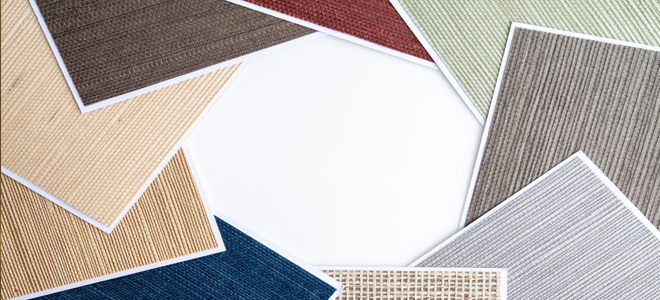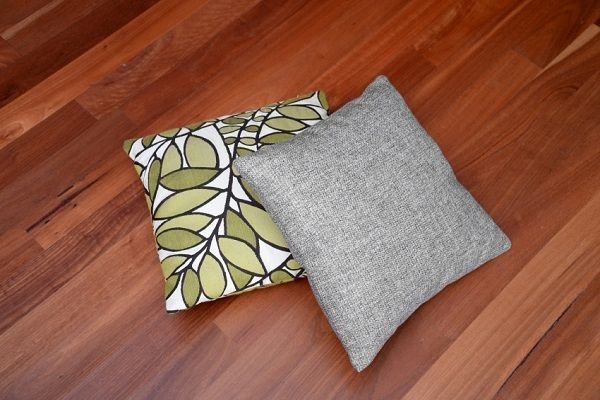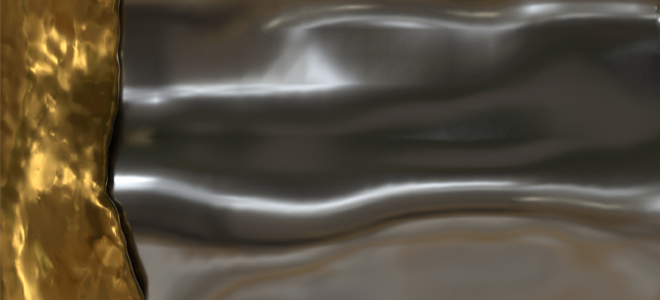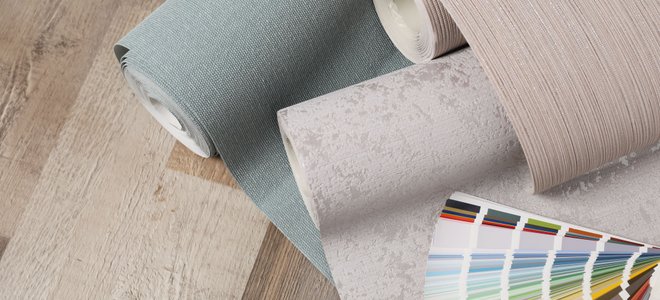If you want to add a level of luxe to your space, consider adding luxury design elements like silk wallpaper.
Installed just like normal wallpaper, silk wallpaper is fabric on the front and paper on the back. This luxury wall treatment is more expensive than traditional wallpaper but brings an instant elevation to any space.
Silk Wallpaper
An interesting and dynamic wall treatment, silk wallpaper is a great way to customize a space and make it feel high-end and layered.
Silk wallpaper dates back to the 1700s, when designer and manufacturer, Jean-Baptiste Réveillon, hired a team to bring his vision for silk wallpaper to life.
Since those first iterations of silk wallpaper, the patterns and applications have changed and adapted to current trends, but at the root, it’s still the same.
One of the main benefits of silk wallpaper is the texture it brings to a space. Because of the subtlety of the texture of the paper, light plays well with this paper, creating a dynamic and living wall feature.
With silk wallpaper a simple pattern goes a long way, because the texture is so important. Even a simple stripe of solid color weave can bring a layered look to your home.
Because silk wallpaper features a natural texture, it blends really well into organic and organic modern home designs. It also incorporates well into traditional, transitional, and grandmillenial designs.
If you’ve been wanting to incorporate this style of paper into your home, picking the right pattern will allow you to blend the silk wallpaper into a variety of decor styles.
Silk wallpaper can also be applied to ceilings. We love this particular application because it’s both interesting and unexpected. Ceiling application does take a skilled hand, but it’s definitely something you could DIY.
Whether your silk wallpaper is being applied to walls or ceiling, be sure to go slow and work out any bubbles. Any imperfection in a silk wallpaper is going to be magnified by the light in the room.
Grasscloth Wallpaper

Similar to silk in texture, grasscloth wallpaper is another fun way to elevate a space and layer in texture and warmth.
Grasscloth is really textural and fun. Our favorite way to see this luxe paper used is in small rooms or spaces, as it makes a big impact.
If you choose to use grasscloth wallpaper in a full bathroom though, make sure that your room has appropriate ventilation. Condensation on grasscloth wallpaper can cause warping and peeling.
You can purchase peel-and-stick grasscloth wallpaper or traditional grasscloth wallpaper in a variety of patterns.
Like silk wallpaper, grasscloth goes really well in homes with organic undertones or transitional design styles. If you pick the right pattern though, you can use grasscloth wallpaper in any design style.
Also like silk wallpaper, grasscloth wallpaper is usually more expensive than traditional wallpaper.
The fun thing about grasscloth paper though, is that there are websites that let you customize the color and pattern, giving you a totally customized look and more control over the final design.
Beadboard
Last on our list of wall treatments that add a little personality and customization to your space is beadboard.
While beadboard has been used for hundreds of years in really traditional designs, there are more modern applications today that make this a great luxe look on a budget.
Beadboard is relatively inexpensive but it does require a little elbow grease and DIY power to be done right.
When installing beadboard, there are a few tips to take this simple material from boring to brilliant.
First, it’s important to pair the beadboard with some sort of trim on top and bottom to encase the board and finish off the look. We love that the type of trim you pick helps the beadboard blend with different design aesthetics.
Ornate trim can make your beadboard feel more traditional while simpler trim often makes the beadboard feel rustic, farmhouse, or coastal.
Second, it’s really important to fill the nail holes and lines where one board joins another. This will give you a much more seamless look.
And lastly, if you want your beadboard to feel custom, we recommend giving it a great paint job. Pick a paint finish that helps you achieve the desired end result in the room.
Use a flat or matte paint for an understated look that blends well, and a high gloss paint for a pop of luxury.
The color of the paint is also an important choice. Our favorite way to paint beadboard is the same color as the existing walls. It gives it a seamless, subtle look that works well for lots of design styles.
But if you want to make a statement, we recommend using a fun pop of color on the beadboard and connecting trim to really draw the eye and make a splash.
As a design material, beadboard is a great choice and can be applied to walls or ceilings.
Curtains
Textiles are another element that can really liven up a space and make it special. If your room feels unfinished, it may be because you’re missing curtains.
There are thousands of curtain options out there, but there are a few choices you can make to select curtains that feel expensive and luxury without having to break the bank.
Custom curtains are incredibly pricey, and if you can’t DIY custom curtains to save money, we have a few tricks to help you get a more custom look for less.
First, when you’re hanging curtains you want to hang them close to the ceiling and at the edges of the window. This will make your room feel bigger and more polished.
Second, when you’re selecting curtains you want a textile with a good weight. Curtains that are too light will move and hang poorly. You can add weights to the bottom of light curtains, but we recommend just starting with a nice thick fabric.
That being said, you don’t have to spend a ton on really expensive curtains. Stores like Ikea have thick curtains for under $100, which is a great deal.
The third thing we recommend when trying to level up your curtains is to steer clear of grommets. Grommets in curtains often make the textile look less expensive.
Instead, opt for something with pleats. If you find regular curtains with no pleats, get pleating hooks and pleat them yourself, DIY style.
This will make your curtains look and function like a luxe set of curtains for way less.
Throw Pillows

Another design material in the textile family that’s important to remember is pillows. Couches, chairs, and beds all benefit from the right throw pillows.
Throw pillows are another area that can get really expensive really quickly, so if you can swing it, DIY throw pillows are a great way to save money and customize your home.
Pillows come in so many shapes and textures, combining different pillows can create a richly layered room that feels warm, inviting, and well put together.
On couches, we like clusters of pillows in threes, usually two square pillows (one larger than the other) and a lumbar pillow. We look to combine colors, shapes, and textures.
While different textile weaves will create different textures in your pillows, if you’re going to be using or sitting by the pillows remember that comfort gets to count too. No one wants to sit by a scratchy boucle pillow, even if it looks really cool.
In bedrooms, layering pillows on the bed can help you create the look and environment you want. Even if you want something super minimal, we recommend at least four pillows.
Start with sleeper pillows and duvet pillows, and then add in any other pillows that complete the look.
As with most things in life, it’s all about editing. Maybe you have a queen size bed and ten pillows you want to use. Ten is probably too many, so edit it down to two sleeper pillows, two duvet pillows, and three to four additional pillows.
Because bedding pillows are purely decorative, for the most part, you can get away with using a cool pillow with great texture, that you wouldn’t necessarily want to sleep on.
And when in doubt, a fun lumbar pillow is a safe bet.
Rugs
Rugs are another design material that makes a huge difference in a space. Like curtains and pillows, rugs aren’t a permanent part of the design, but they can make a huge impact.
The key to a great room is often grounding the space with the right rug. Rugs come in a variety of weaves and textures, giving you ample options that complement your room.
You don’t just want to think about patterns in your space, though that is certainly important, you also want to think about texture.
A beautifully woven jute rug is going to function very differently than a carpet rug in a room. You have to think about the use and application.
If you’ve got lots of littles, a rug with a stiff weave is going to be harsh on their skin as they play on the rug. If you have a high-traffic area, you may want a rug with a tighter weave that holds up to traffic better.
Also, consider the ease of cleaning. Some rugs are a lot easier to clean than others, which is important if the rug is going under your kitchen table or another area where it’s bound to get dirty.
The size of your rug is the factor that will determine if it makes your room feel bigger and more luxurious or smaller and more disjointed.
A rug that’s too small for a space throws the whole room off balance. As a rule of thumb, all of the major furniture in your room needs to at least touch the rug.
If you’ve got a couch, chairs, an ottoman, and a TV console in a living room, all of those elements need to at least touch the rug in order for the space to feel cohesive and connected.
If you choose to layer two rugs, we still recommend that all of the furniture touch both rugs.
Floating Shelves
Floating shelves are another great design material that can bring real wood into a space that’s lacking warmth and depth.
When you select the right floating shelves, you not only give yourself increased storage, but you’ll also expand the footprint of the room and give yourself more design space and visual interest.
Great floating shelves are themselves a design aspect.
If you are trying to pick the right wood type or color for your floating shelves, we recommend matching the undertones in your space. If your whole house is warm, use warm wood, if you’ve got lots of greys and blues, use cool-toned wood.
Not all floating shelves are created equally. You can DIY your own floating shelves from start to finish or purchase a hidden bracket that you can build your shelves around.
If you are purchasing floating shelves, we recommend looking for something with a high-weight rating and that attaches directly to your studs. Attaching a shelf using drywall anchors only can cause damage to your walls.
If you want floating shelves but are looking for something more unique, try customizing the shelves with brass railings, wine racks, or a routered edge for an added element of interest.
Metals

Metals are the last design element on our list, and the great thing about incorporating metals into your home is that they can help marry the design of the entire home together.
Picking one or two metals to use on finishes throughout your entire space lends cohesion to your home that makes it feel professionally designed.
You can definitely mix metals in a home, in fact, we recommend it if you want something that feels high-end. That being said, we do not recommend mixing lots of different metals and finishes.
If you opt for shiny brass, don’t add matte silver and matte gold, and shiny chrome. It gets messy and chaotic really quickly.
Instead, remember to edit yourself and make strategic choices that enhance the look you’re going for without complicating things.
Pick a few metals and finishes and then use those throughout the space anywhere that calls for it, like handles and pulls, lights, and doorknobs.

